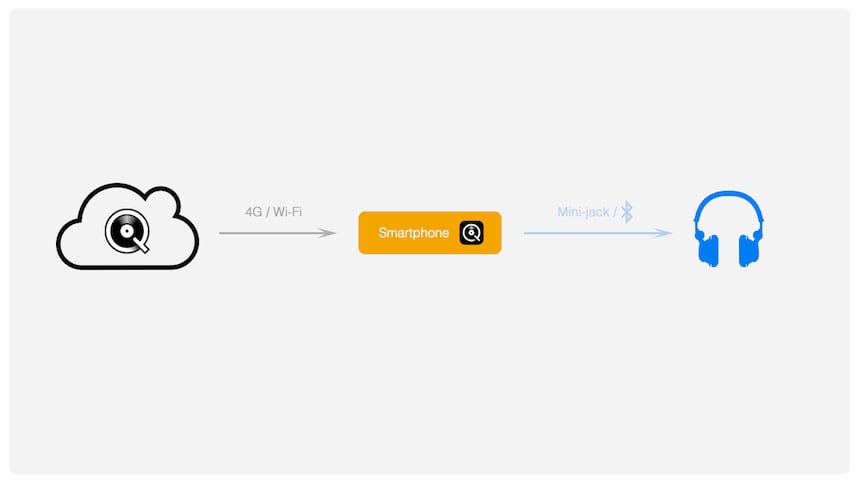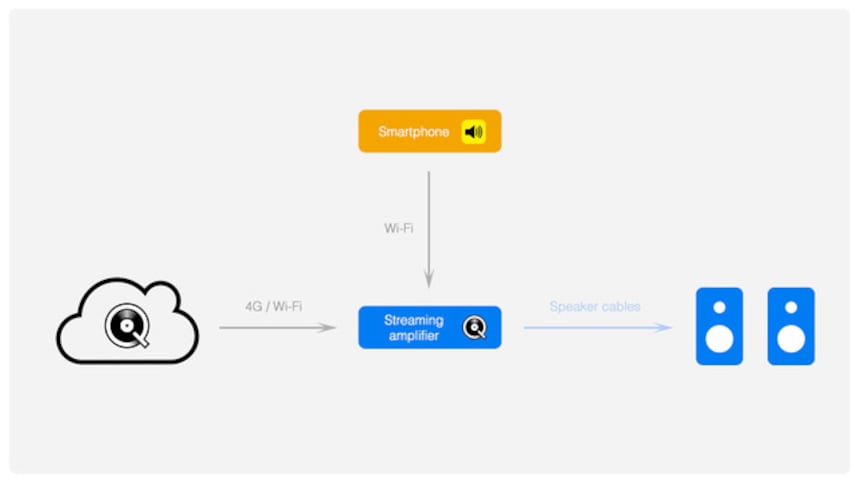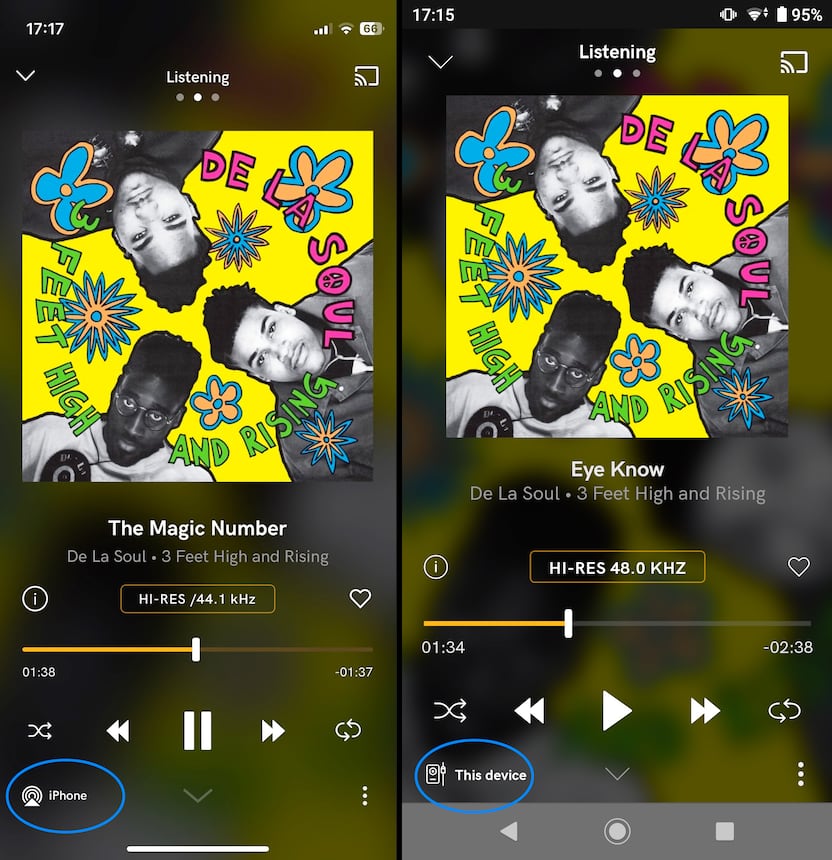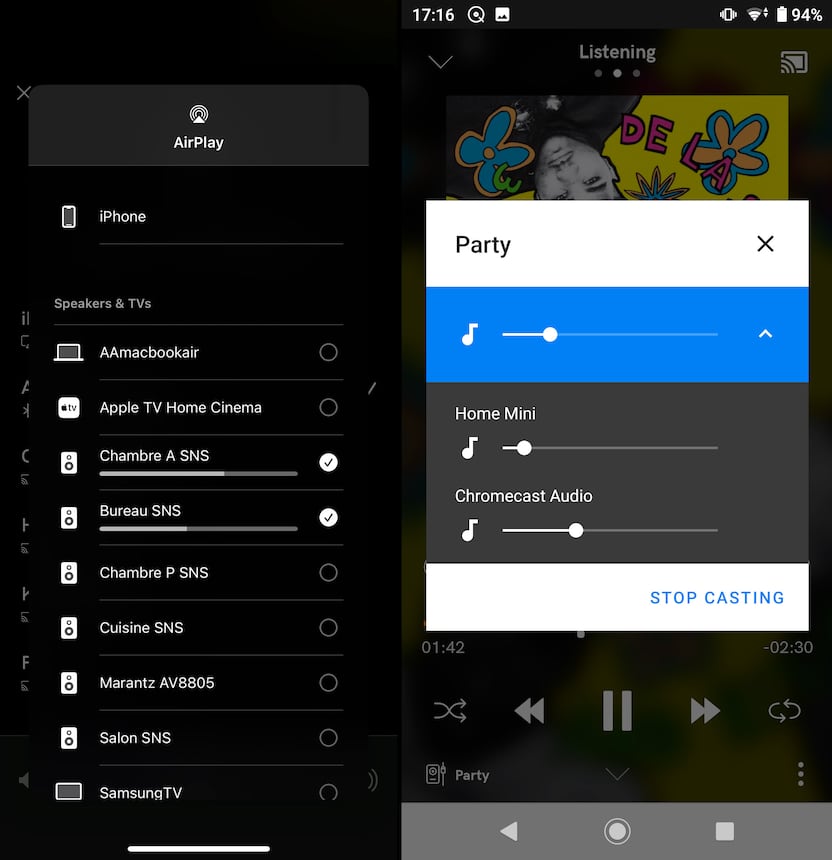Streaming to headphones or speakers via your smartphone
When using the Qobuz app, all you have to do is select a song to have it play on your smartphone, tablet or PC. If you’re using a portable device, then you’ll probably be listening with wireless headphones or a Bluetooth speaker. With a PC, you’re more likely to be listening through the audio output: headphones, computer speakers or a wired connection to an external DAC.
The Qobuz app connects to the Qobuz servers, receives the music and plays it directly through the audio outputs of the relevant playback device. This is the simplest playback configuration, ideal for the average listener’s needs.

The Qobuz app serves as a comprehensive music player: it retrieves the music, sends it to the audio output and controls the volume. Its operation is linear, so while this means other elements can’t interrupt the music stream, it does mean that playback from the Qobuz app is only intended for one audio output at a time.
Streaming Qobuz directly through a HiFi system
There are hundreds of audio devices with integrated Qobuz, meaning you don’t necessarily need to use a smartphone or PC to access the Qobuz servers: you can use the HiFi equipment itself. If you’re using one of these devices, you’ll no longer use the Qobuz app since this is replaced by an app created by the device manufacturer.
In this case, the music path is different. You use the manufacturer’s app to select a song in Qobuz, which then tells the HiFi device to play it. It also controls the system’s volume. Essentially, this application serves as a remote control, not a music player.

The devices that feature integrated Qobuz are those found at the heart of every HiFi setup: network players (streamers), connected amplifiers, and wireless speakers. These can either create a connected set or add the Qobuz function to an existing system. This can be done without a computer or Bluetooth connection.
Hi-Res playback is another benefit that comes with integrated Qobuz. For example, high-resolution sound quality is often lost between a smartphone and a Bluetooth speaker. Integrating the service into a HiFi device guarantees playback up to Hi-Res 192/24.
Another benefit is that you won’t necessarily need a smartphone or tablet to initiate playback. A number of devices connected to Qobuz have their own interface. For some, this will take the form of pre-set buttons or remote control, enough to launch your favourite playlist. Others will feature a complete interface with a display screen that allows for extensive music selection.
Listen to Qobuz on all your household speakers
Qobuz playback on multiple speakers is only possible using connected audio equipment. Multi-room audio allows you to listen to music across two or more rooms, and this can be combined with Qobuz. All you have to do is choose equipment that features integrated Qobuz and has multi-room broadcasting functionality, such as BluOS (Bluesound, NAD, Dali), MusicCast (Yamaha), Sonos, Cabasse, Electrocompaniet, KEF, Naim, etc.
Once the music is playing on the manufacturer’s integrated app, you can group rooms together to listen to the same thing throughout the house. You can also play different music in each room or create sub-groups (e.g. different music on each floor).
This multicasting function is possible with Qobuz, but only through our partners’ certified devices. Be aware that each brand uses its own broadcasting protocol, which makes it incompatible with its competitors. If you’re wanting to equip several rooms, it’s always best to stick with the same manufacturer to avoid any nasty surprises.
AirPlay & Chromecast: The Alternatives
Last but not least, there’s a solution somewhere in the middle. The AirPlay 2 and Chromecast protocols allow music to be sent to HiFi devices whilst still using a smartphone as the music player. These two are fierce competitors, with the former being owned by Apple and the latter by Google.
A number of connected HiFi devices come with these protocols integrated; some offer both protocols, whilst others have picked a side. Just make sure you choose equipment that’s compatible with your smartphone or tablet.
Any HiFi device with AirPlay 2 and/or Chromecast is compatible with Qobuz playback. However, you’ll need a smartphone with the Qobuz app to connect to the Qobuz servers.

Simply launch playback from the Qobuz app and then tap on the small icon at the bottom left to play the music on another device. This playback is done via WiFi and provides a minimum of CD-quality sound.
With AirPlay 2, you can add several speakers directly in the app. With Chromecast, you’ll need to create speaker groups beforehand via the Google Home app if you want playback in more than two rooms at once.

In summary, choosing a HiFi device with integrated Qobuz means you can benefit from high-resolution sound and multi-room playback. Plus, you won’t necessarily need your smartphone. These devices are a great alternative to direct playback on smartphones, tablets and PCs. However, not all manufacturer’s integrated Qobuz apps offer the same functionality. Whilst some include all the core Qobuz functions, including some of the editorial content, others focus solely on providing access to key tracks and recommended songs.